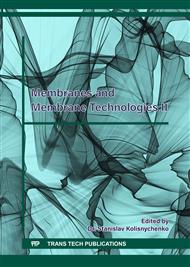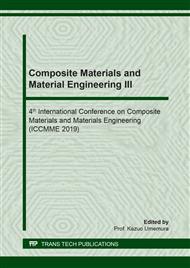p.292
p.298
p.304
p.313
p.319
p.325
p.331
p.337
p.345
Nanostructured Membrane of Sodium Montmorillonite Reinforced Cellulose Acetate for Adsorption of Ca(II) and Mg(II) Ions in Hard Water
Abstract:
Permanent hard water softening was conducted with the use of cellulose acetate (CA)/sodium montmorillonite (Na+-MMT) nanostructured membranes. Fabrication of the nanostructured membranes with various Na+-MMT loading (0%, 5%, 10%, 15%) was made possible by electrospinning technique, which was carried out at 25°C, 30 kV applied voltage, needle size of 25G and a tip to collector distance of 18 cm. The effect of Na+-MMT content on the morphology of the fiber was examined with the use of Scanning Electron Microscope (SEM). It was determined that increasing the Na+-MMT loading decreases the average fiber diameter. The molecular structure of the blend nanostructured membranes were investigated using Fourier Transform Infrared (FTIR) Spectroscopy and the existence of CA and Na+-MMT in the electrospun nanostructured membrane was confirmed. Better adsorption performance was observed for the blend with 15% Na+-MMT as compared to pure CA and maximum uptake rate was attained at 7 hours for pure CA and only 5 hours for CA/Na+-MMT (85%/15%) blend. Increasing the initial hard water concentration increases the driving force for diffusion and in turn increases adsorption capacity of both pure CA and the CA/Na+-MMT (85%/15%) blend. More so, the results of the experiment best fitted the pseudo-second order kinetic model and the Freundlich isotherm model. Integration of Na+-MMT in CA increases the surface area for adsorption of the nanostructured membrane, and thus, could be used as an effective adsorbent for hard water softening.
Info:
Periodical:
Pages:
319-324
Citation:
Online since:
May 2019
Price:
Сopyright:
© 2019 Trans Tech Publications Ltd. All Rights Reserved
Share:
Citation:



